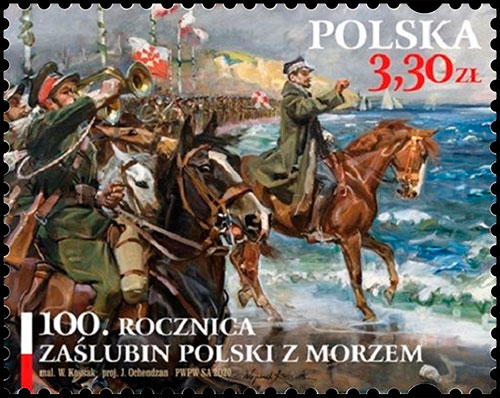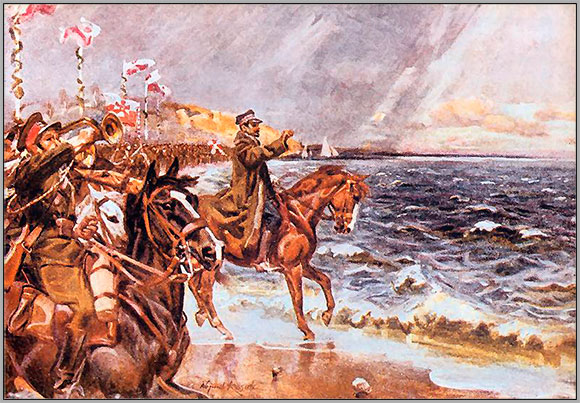
On February 10, 2020, the Polish Post issued a postage stamp marking the centenary of Poland's restoration of access to the Baltic Sea. The ceremony was given the poetic title "Wedding of Poland to the Sea".
After the partition of the Polish-Lithuanian Commonwealth in 1793, Poland lost access to the Baltic waters for a long time, and it was only after the end of the First World War in 1919, that the country regained its port on the Baltic coast. According to the Versailles Treaty, Poznan and several regions of Pomerania and East Prussia, were transferred away from Germany and ceded to Poland. As a result of these territorial acquisitions, the Polish Corridor was formed with access to the Baltic Sea in the port city of Puck.
To strengthen patriotic feelings in the local population and to celebrate the significant success of the state's foreign policy in 1920, a solemn ceremony of Poland's betrothal to the sea was held, which had a deep symbolic meaning.
On February 10, 1920, General Jozef Haller with a soldier's train arrived in Puck, the new Polish "sea capital". From the station, the general, accompanied by a detachment of lancers, set off to the sea on horseback. There, in a dignified atmosphere, the ceremony of "betrothal" was held. The general threw into the sea one of the platinum rings he received from members of the Polish community of the Free City of Danzig. The general put the second ring on the tip of the military flag of Poland, after which the banner with the ring was solemnly dipped into the sea water. After that, a church service according to the Roman Catholic rite took place and the military chaplain Józef Vryča consecrated the banner. The official speeches on the day emphasized the importance of Poland's access to the sea in stimulating socio-economic development.

The postage stamp reproduces a painting by the Polish artist Wojciech Kossak, painted in 1931, which is called "The Wedding of Poland to the Sea". The painting is kept in the Museum of the Polish Army in Warsaw. Wojciech Kossak is a famous Polish artist who painted historical and battle scenes, as well as portraits and paintings on military themes. By the way, in this case, the artist did not wholly accurately depict the landmark historical event. In his memoirs, General Haller wrote that, on the day of the ceremony, the Puck Bay was covered with ice and in order to throw the ring into the water, an ice-hole had to be cut.
A few years later, a memorial plaque with the Polish eagle and the date of the commemorative event was erected at the site of the ceremony in Puck. It should be noted that, from that point, the "sea dominion" of Poland lasted only 19 years. In 1939, Nazi Germany again deprived Poland of its access to the sea, and only after the end of World War II in 1945, was Poland again restored access to the Baltic. On March 17, 1945, the Polish army “renewed marriage vows” in the village of Mrzezyno, and the next day in the town of Kolobrzeg.
P.S. This story reminded me of another, much earlier event, also related to the sea. When the Persian king Xerxes, during a campaign in Greece in 480 BC. through the fault of the raging sea, lost an army and the battle at Salamis. According to legend, the angry king ordered his executioners to whip the sea with whips as punishment. This time the sea was much more fortunate - it got married.
Перейти в каталог


